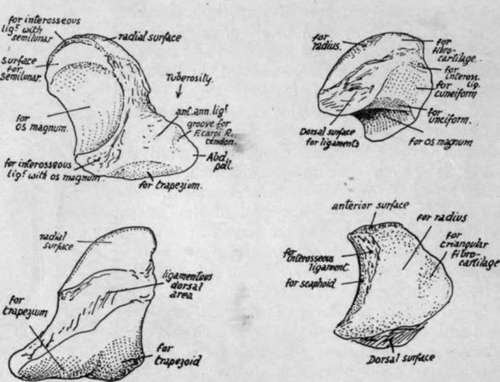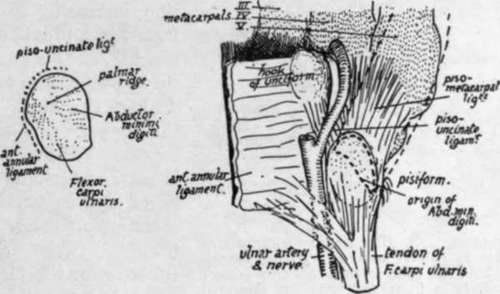Scaphoid
Description
This section is from the book "The Anatomy Of The Human Skeleton", by J. Ernest Frazer. Also available from Amazon: The anatomy of the human skeleton.
Scaphoid
Upper radial facet convex : inner facet is crescentic for semilunar, and below this a large concavity for head of os magnum. A small rough area between radial and semilunar facets is for interosseous ligament connecting it with semilunar. Lower surface rests on trapezium and trapezoid, and is divided into corresponding areas by a badly-marked ridge. Dorsal surface is encroached upon by the lower and upper articular surfaces, so is only represented by a narrow rough strip for dorsal ligaments of the wrist.

Fig. 86.-On the left, a left scaphoid : top figure, from the front; lower figure, dorsal view. On the right, left semilunar: upper figure, from behind and internally ; lower figure, from above.
Anterior surface presents a concavity or notch, below which is the prominent tuberosity. The upper parts of the deeper fibres of the anterior annular ligament are attached to the tuberosity, which may, as in the figure, show a ridge for this, with a groove external to it for the tendon of F. carpi radialis : further in is a ligamentous area d this may be enlarged in the angle between the trapezoid and os magnum surfaces by the attachment here of an interosseous band connecting the bone with the os magnum.
Abductor polhcis gets some slight origin from the tuberosity outside the groove for the radial flexor.
Semilunar
Rather obliquely placed, in an upward and inward direction. A deep concavity below for head of os magnum, a flattened four-sided facet on inner side for cuneiform, and between these two, on the lower and inner angle, an elongated strip of articular surface for unciform. Outer facet for scaphoid is elongated and crescentic, with a roughened area above it for the interosseous ligament between the bones : a similar band is on the ulnar side, connecting it with the cuneiform and attached above the facet for that bone, on the edge that separates it from the upper articular surface, but a definite marking is frequently wanting (see Fig. 86).
Upper articular surface extends on to dorsal surface in its outer part : this is for the radius ; but the inner part of the surface, more on the upper aspect of the bone, is for the triangular fibro-cartilage, and the two areas, though continuous, are sometimes separately recognisable on the bone. As a result of this the dorsal surface is diminished, particularly its outer part, and is a roughened and purely ligamentous one. Anterior surface, larger than the dorsal, has only weak ligamentous bands attached to it, and is not much roughened.

Fig. 87.-Palmar aspect of pisiform. On the right the bone is shown in position ; the Abductor minimi digiti is indicated by interrupted lines in its position lying on the ligamentous fibres connecting pisiform with bases of metacarpals. Observe that the oblique and raised anterior ridge is directed downwards and outwards ; this enables one to place the bone on its proper side.
Cuneiform
Three-sided pyramid with its base resting against the semilunar, its apex directed downwards and inwards, an inferior surface concavo-convex and resting on unciform, a postero-superior surface carrying a small facet for the fibro-cartilage, but otherwise rough for ligaments, and an antero-superior (anterior) surface ligamen tous, but with a facet on its inner part for the pisiform.
Pisiform
A small nodular bone with an articular facet on its dorsal surface, which rests on the front aspect of the cuneiform. Its long axis runs from above downwards and outwards, directed toward the hook of the unciform : the piso-uncinate hgament is attached to the distal extremity, sometimes making a marked tubercle. The tubercle is continuous with an obhque line visible on the radial aspect of the bone : the line gives attachment to the anterior annular ligament and some fibres of F. carpi ulnaris, the remainder of the tendon running on to the proximal and palmar surfaces of the bone. A slightly hollowed surface lies between the radial hne and the dorsal articulation, increasing in depth as it is traced in a proximal direction, and making, at this end, a characteristic hollow on the radial side which enables the observer to recognise the upper end-and the outer aspect. The inner or ulnar surface is marked by faint striations from fibres of the posterior annular ligament which reach it. In front of these, between them and the tubercle for the piso-uncinate ligament, is an area for attachment of piso-metacarpal fibres. The Abductor minimi digiti arises from the front of the bone between these various areas, and extends on to the different ligamentous fibres occupying the surrounding surfaces. The deep hollow at its proximal (radial) side is occupied by a fibrous pad connecting the flexor sheath with the posterior annular ligament.
Trapezium
Upper surface has facet slightly concave from before backwards for scaphoid, and outside and behind this a ligamentous area for external lateral ligament. An internal surface concave from above down for articulation with trapezoid. The bone has its lower back and inner part prolonged down to articulate with the outer side of the base of the metacarpal of index finger, so that its lower aspect shows this facet looking downwards and inwards, and further out and proximally a concavo-convex surface for the metacarpal of the thumb-looking downwards and outwards.
Continue to:
